Chapter: Essentials of Anatomy and Physiology: The Senses
The Eye - Structure, Anatomy and Physiology
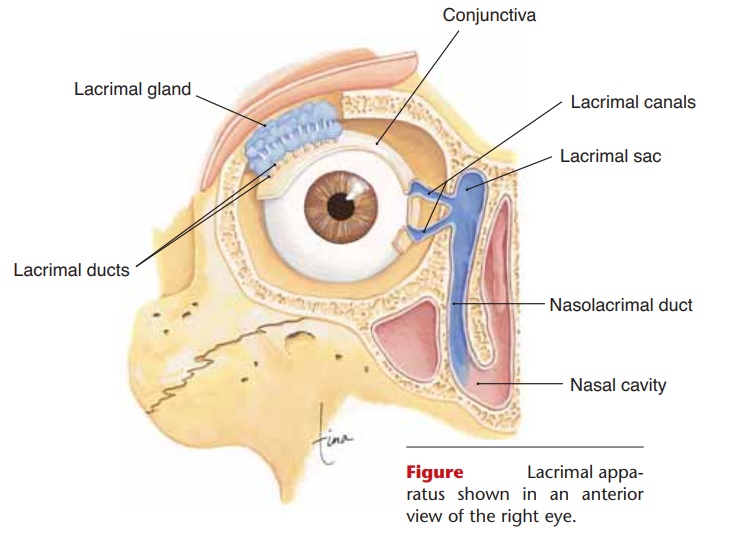
THE EYE
The eye contains the receptors for vision and a refracting system that focuses light rays on the recep-tors in the retina. We will begin our discussion, how-ever, with the accessory structures of the eye, then later return to the eye itself and the physiology of vision.
EYELIDS AND THE LACRIMAL APPARATUS
The eyelids contain skeletal muscle that enables the eyelids to close and cover the front of the eyeball. Eyelashes along the border of each eyelid help keep dust out of the eyes. The eyelids are lined with a thin membrane called the conjunctiva, which is also folded over the white of the eye and merges with the corneal epithelium. Inflammation of this membrane, called conjunctivitis, may be caused by allergies or by certain bacteria or viruses, and makes the eyes red, itchy, and watery.
Tears are produced by the lacrimal glands, located at the upper, outer corner of the eyeball, within the orbit (Fig. 9–3). Secretion of tears occurs constantly, but is increased by the presence of irri-tating chemicals (onion vapors, for example) or dust, and in certain emotional situations (sad or happy). Small ducts take tears to the anterior of the eyeball, and blinking spreads the tears and washes the surface of the eye. Tears are mostly water, with about 1% sodium chloride, similar to other body fluids. Tears also contain lysozyme, an enzyme that inhibits the growth of most bacteria on the wet, warm surface of the eye. At the medial corner of the eyelids are two small openings into the superior and inferior lacrimal canals. These ducts take tears to the lacrimal sac (in the lacrimal bone), which leads to the nasolacrimal duct, which empties tears into the nasal cavity. This is why crying often makes the nose run.
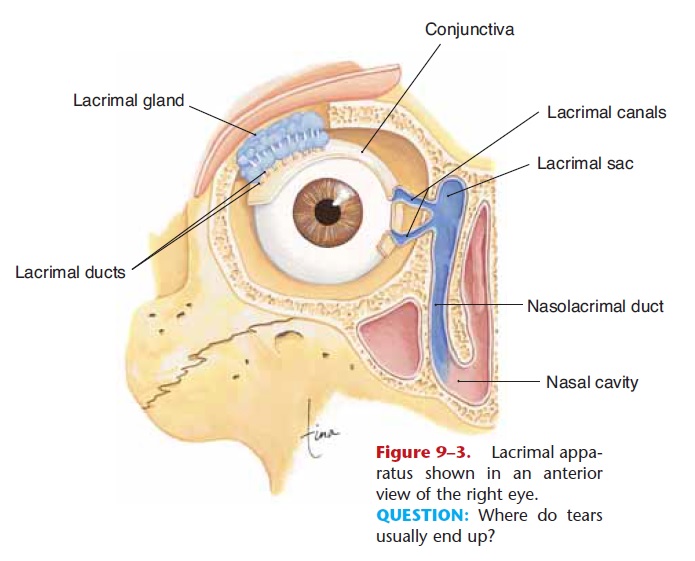
Figure 9–3. Lacrimal appa-ratus shown in an anterior view of the right eye.
QUESTION: Where do tears usually end up?
EYEBALL
Most of the eyeball is within and protected by the orbit, formed by the lacrimal, maxilla, zygomatic, frontal, sphenoid, and ethmoid bones. The six extrin-sic muscles of the eye (Fig. 9–4) are attached to this bony socket and to the surface of the eyeball. There are four rectus (straight) muscles that move the eyeball up and down or side to side; the name tells you which direction. The medial rectus muscle, for example, pulls the eyeball medially, as if to look at the nose. The two oblique (slanted) muscles rotate the eye. The cra-nial nerves that innervate these muscles are the oculo-motor, trochlear, and abducens (3rd, 4th, and 6th cranial nerves, respectively). The very rapid and com-plex coordination of these muscles in both eyes is, for-tunately, not something we have to think about. The convergence of both eyes on an object is very impor-tant to ensure a single image (that is, to prevent dou-ble vision) and to give us depth perception and a three-dimensional world.
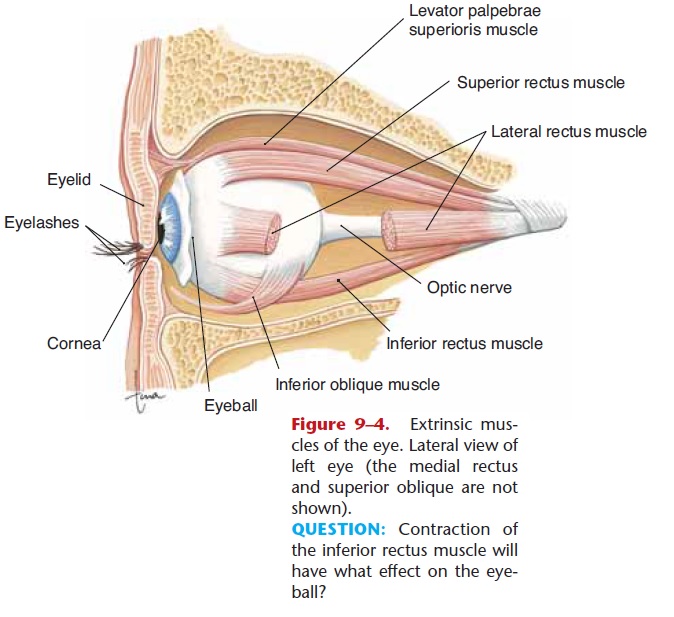
Figure 9–4. Extrinsic mus-cles of the eye. Lateral view of left eye (the medial rectus and superior oblique are not shown).
QUESTION: Contraction of the inferior rectus muscle will have what effect on the eye-ball?
Layers of the Eyeball
In its wall, the eyeball has three layers: the outer sclera, middle choroid layer, and inner retina (Fig. 9–5). The sclera is the thickest layer and is made of fibrous connective tissue that is visible as the white of the eye. The most anterior portion is the cornea, which differs from the rest of the sclera in that it is transparent. The cornea has no capillaries, covers the iris and pupil inside the eye, and is the first part of the eye that refracts, or bends, light rays.
The choroid layer contains blood vessels and a dark blue pigment (derived from melanin) that absorbs light within the eyeball and thereby prevents glare (just as does the black interior of a camera). The anterior portion of the choroid is modified into more specialized structures: the ciliary body and the iris. The ciliary body (muscle) is a circular muscle that surrounds the edge of the lens and is connected to the lens by suspensory ligaments. The lens is made of a transparent, elastic protein, and, like the cornea, has no capillaries. The shape of the lens is changed by the ciliary muscle, which enables the eye to focus light from objects at varying distances from the eye.
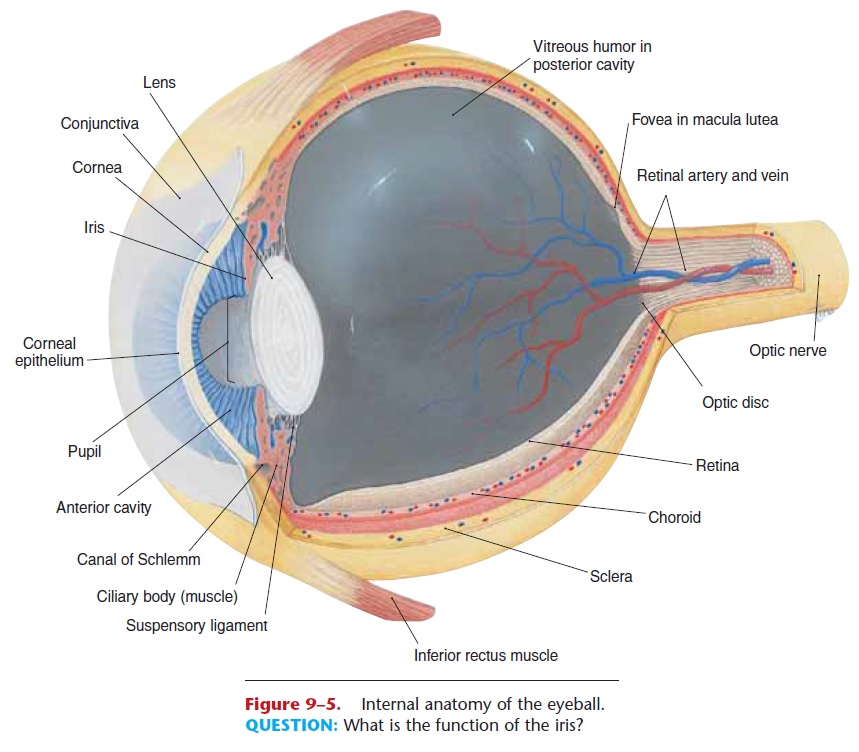
QUESTION: What is the function of the iris?
Just in front of the lens is the circular iris, the col-ored part of the eye; its pigment is a form of melanin.
What we call “eye color” is the color of the iris and is a genetic characteristic, just as skin color is. Two sets of smooth muscle fibers in the iris change the diame-ter of the pupil, the central opening. Contraction of the radial fibers dilates the pupil; this is a sympathetic response. Contraction of the circular fibers constricts the pupil; this is a parasympathetic response (oculo-motor nerves). Pupillary constriction is a reflex that protects the retina from intense light or that permits more acute near vision, as when reading.
The retina lines the posterior two-thirds of the eyeball and contains the visual receptors, the rods and cones (Fig. 9–6). Rods detect only the presence of light, whereas cones detect colors, which, as you may know from physics, are the different wavelengths of visible light. Rods are proportionally more abundant toward the periphery, or edge, of the retina. Our best vision in dim light or at night, for which we depend on the rods, is at the sides of our visual fields. Cones are most abundant in the center of the retina, espe-cially an area called the macula lutea directly behind the center of the lens on what is called the visual axis. The fovea, which contains only cones, is a small depression in the macula and is the area for best color vision.
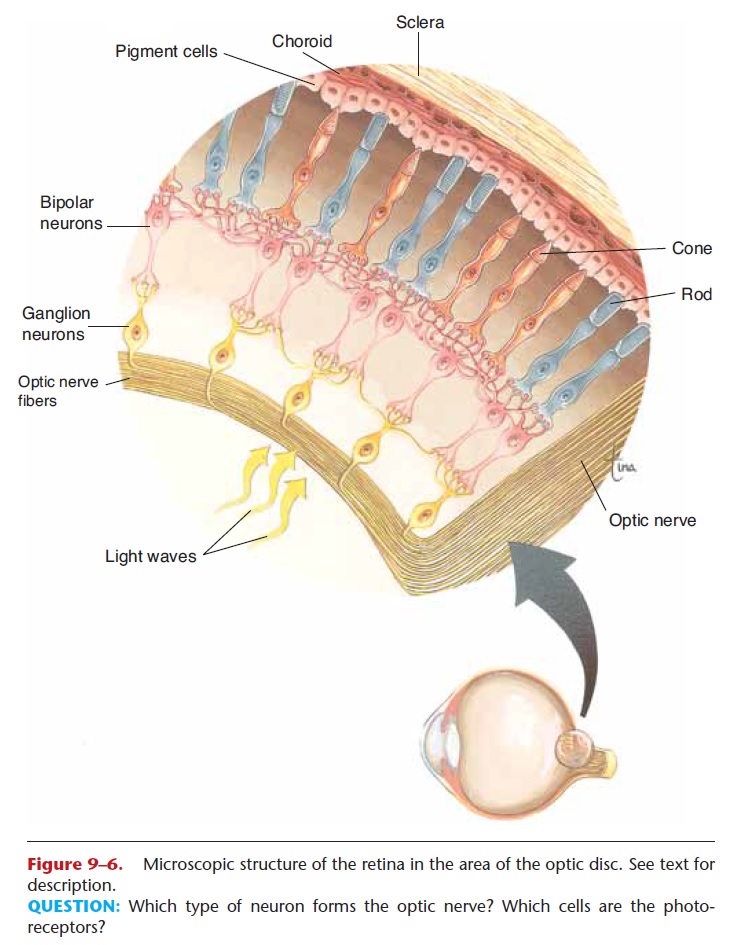
Figure 9–6. Microscopic structure of the retina in the area of the optic disc. See text for description.
QUESTION: Which type of neuron forms the optic nerve? Which cells are the photo-receptors?
An important cause of vision loss for people over 65 years of age is age-related macular degeneration (AMD), that is, loss of central vision, and some cases seem to have a genetic component. In the dry form of AMD, small fatty deposits impair circulation to the macula, and cells die from lack of oxygen. In the wet form of AMD, abnormal blood vessels begin leaking into the retina, and cells in the macula die from the damaging effects of blood outside its vessels. The macula, the center of the visual field, is the part of
the retina we use most: for reading, for driving, for recognizing people, and for any kind of close work. People of all ages should be aware of this condition and that smoking and exposure to ultraviolet rays are risk factors.
When light strikes the retina, the rods and cones generate impulses. These impulses are carried by gan-glion neurons, which all converge at the optic disc(see Figs. 9–5 and 9–6) and pass through the wall of the eyeball as the optic nerve. There are no rods or cones in the optic disc, so this part of the retina is sometimes called the “blind spot.” We are not aware of a blind spot in our field of vision, however, in part because the eyes are constantly moving, and in part because the brain “fills in” the blank spot to create a “complete” picture.
Cavities of the Eyeball
There are two cavities within the eye: the posterior cavity and the anterior cavity. The larger, posterior cavity is found between the lens and retina and con-tains vitreous humor (or vitreous body). This semi-solid substance keeps the retina in place. If the eyeball is punctured and vitreous humor is lost, the retina may fall away from the choroid; this is one possible cause of a detached retina.
The anterior cavity is found between the back of the cornea and the front of the lens, and contains aqueous humor, the tissue fluid of the eyeball. Aqueous humor is formed by capillaries in the ciliary body, flows anteriorly through the pupil, and is reab-sorbed by the canal of Schlemm (small veins also called the scleral venous sinus) at the junction of the iris and cornea. Because aqueous humor is tissue fluid, you would expect it to have a nourishing function, and it does. Recall that the lens and cornea have no capil-laries; they are nourished by the continuous flow of aqueous humor.
PHYSIOLOGY OF VISION
For us to see, light rays must be focused on the retina, and the resulting nerve impulses must be trans-mitted to the visual areas of the cerebral cortex in the brain
Refraction of light rays is the deflection or bend-ing of a ray of light as it passes through one object and into another object of greater or lesser density. The refraction of light within the eye takes place in the fol-lowing pathway of structures: the cornea, aqueous humor, lens, and vitreous humor. The lens is the only adjustable part of the refraction system. When looking at distant objects, the ciliary muscle is relaxed and the lens is elongated and thin. When looking at near objects, the ciliary muscle contracts to form a smaller circle, the elastic lens recoils and bulges in the middle, and has greater refractive power.
When light rays strike the retina, they stimulate chemical reactions in the rods and cones. In rods, the chemical rhodopsin breaks down to form scotopsin and retinal (a derivative of vitamin A). This chem-ical reaction generates an electrical impulse, and rhodopsin is then resynthesized in a slower reaction. Adaptation to darkness, such as going outside at night, takes a little while because being in a well-lit area has broken down most of the rhodopsin in the rods, and resynthesis of rhodopsin is slow. The opposite situa-tion, perhaps being suddenly awakened by a bright light, can seem almost painful. What happens is this: In darkness the rods have resynthesized a full supply of rhodopsin, and the sudden bright light breaks down all the rhodopsin at the same time. The barrage of impulses generated is very intense, and the brain may interpret any intense sensation as pain. A few minutes later the bright light seems fine because the rods are recycling their rhodopsin slowly, and it is not breaking down all at once.
Chemical reactions in the cones, also involving retinal, are brought about by different wavelengths of light. It is believed that there are three types of cones: red-absorbing, blue-absorbing, and green-absorbing cones. Each type absorbs wavelengths over about a third of the visible light spectrum, so red cones, for example, absorb light of the red, orange, and yellow wavelengths. The chemical reactions in cones also generate electrical impulses.
The impulses from the rods and cones are trans-mitted to ganglion neurons (see Fig. 9–6); these con-verge at the optic disc and become the optic nerve, which passes posteriorly through the wall of the eye-ball. Ganglion neurons also seem to have a photo-receptor chemical (called melanopsin) that may contribute to the daily resetting of our biological clocks.
The optic nerves from both eyes come together at the optic chiasma (or chiasm), just in front of the pituitary gland (see Fig. 8–11). Here, the medial fibers of each optic nerve cross to the other side. This cross-ing permits each visual area to receive impulses from both eyes, which is important for binocular vision.
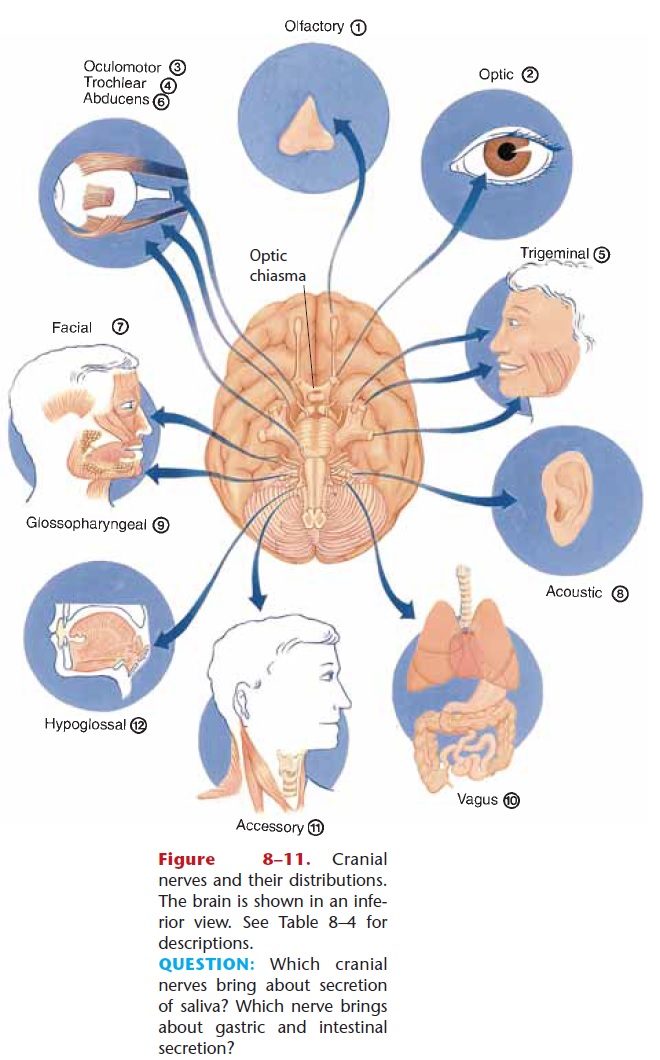
The visual areas are in the occipital lobes of the cerebral cortex. Although each eye transmits a slightly different picture (look straight ahead and close one eye at a time to see the difference between the two pic-tures), the visual areas put them together, or integrate them, to make a single image that has depth and three dimensions. This is called binocular vision. The visual areas also right the image, because the image on the retina is upside down. The image on film in a cam-era is also upside down, but we don’t even realize that because we look at the pictures right side up. The brain just as automatically ensures that we see our world right side up.
Also for near vision, the pupils constrict to block out peripheral light rays that would otherwise blur the image, and the eyes converge even further to keep the images on the corresponding parts of both retinas.
The importance of pupil constriction can be demon-strated by looking at this page through a pinhole in a piece of paper. You will be able to read with the page much closer to your eye because the paper blocks out light from the sides.
The importance of convergence can be demon-strated by looking at your finger placed on the tip of your nose. You can feel your eyes move medially (“cross”) in maximum convergence. If the eyes don’t converge, the result is double vision; the brain cannot make the very different images into one, and settles for two. This is temporary, however, because the brain does not like seeing double and will eventually sup-press one image.
You have probably heard of the condition called “lazy eye” (the formal name is strabismus), in which a person’s eyes (the visual axis of each) cannot be directed at precisely the same point. True convergence is not possible and, if untreated, the brain simply will not use the lazy eye image. That eye may stop focus-ing and become functionally blind because the brain is ignoring the nerve impulses from it. Such loss of vision is called amblyopia. Correction of a lazy eye may involve eye exercises (to make the lazy eye straighten out), a patch over the good eye (to make the lazy eye straighten out and take over), or surgery to correct an imbalance of the extrinsic muscles. You can show yourself the benefits of converging eyes the next time you are a passenger in a car (not the driver). As the car is moving, close one eye. Does the oncoming landscape seem to flatten out, lose dimension? This is loss of depth perception and some of the three dimen-sionality that our brains provide.
Related Topics